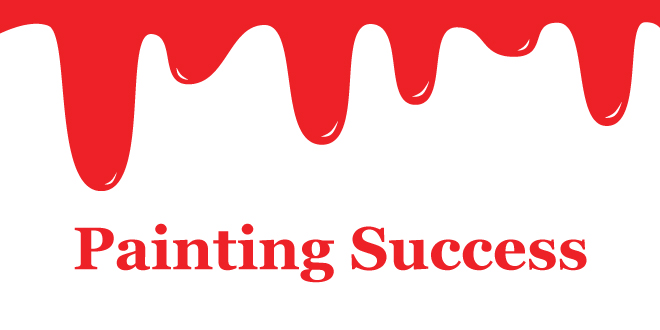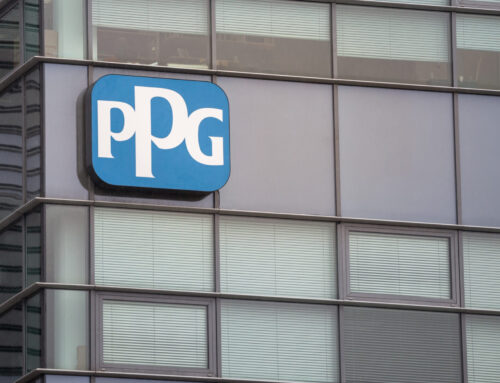A natural extension of their full-service visual communications company Banner Sign Co., Nicholas and Nicole Piach opened The Color Bloc in Detroit, Michigan, in 2021. Richard Fleming, who has been with the operation since shortly after it opened, serves as the general manager of the 2,000-square-foot store. Fleming shares how he has curated the store’s 350-square-foot specialty paints and coatings section and the best practices that have led to its success.

Richard Fleming, general manager of The Color Bloc in Detroit, works hard to ensure his team has the knowledge to assist customers.
All About Alkyd: Learn about oil-modified specialty paint options and how to sell them to customers at PDRmag.com/alkyd-paint.
Choose the Right Products
Located in Detroit’s Milwaukee Junction neighborhood, The Color Bloc serves a customer base of 60% professional and 40% DIY.
“We are located in a historic industrial or mixed-use area so our customers mainly need specialty paints and coatings for their building maintenance and restoration projects,” Fleming says. “We also carry a lot of industrial coatings or coatings for machinery and safety purposes.”
The operation also caters to groups of local urban artists.
“We have built relationships with some local artists who use different reclaimed materials for a variety of projects,” Fleming says. “Finding and using the proper specialty paints and coatings in the correct way is key to the success of their projects. Being able to consistently provide specialty paints and coating knowledge has boosted customer loyalty and sales.”
Like most other independent home improvement operations, The Color Bloc’s customers have influenced its inventory.

“Being able to consistently provide specialty paint and coating knowledge has boosted customer loyalty and sales.”
—Richard Fleming, The Color Bloc

Customers are not the only influence on The Color Bloc’s specialty paints and coating product offerings. New Michigan standards enacting additional volatile organic compound (VOC) limits in 14 categories—including industrial maintenance, rust preventatives and floor coatings—means the operation is working diligently to add compliant versions and seek solutions and substitutions for products that are no longer available for purchase in Michigan.
“We have a few years to sell the products on our shelves that don’t meet the new standards. But if a customer starts a project with one of those products, we’ll have issues getting more if they underestimate how much they need,” Fleming says. “We can still technically get banned products—it just requires a lot of paperwork and fees. So it is easier, in my opinion, to focus on finding suitable substitutes.”
Fleming relies on the store’s territory representatives when looking for alternatives and substitutions for banned products.
“I like to give customers multiple product recommendations and pros and cons for each,” Fleming says. “Our territory representatives are key resources I utilize for immediate answers on substitutions I have questions about.”
Offer Comprehensive Training
The regulation change also led Fleming to adjust how he trains on this subject.
“It is important the entire staff understands what products are affected by the regulation change and what substitutes are available so we can serve our customers to the best of our ability and avoid any issues,” Fleming says.
Specialty paints and coatings include a broad range of products that can be difficult to understand and challenging to learn. Investing in employees and their education leads to better customer service and higher sales. Due to the complexity of the products, Fleming says it is one of the last sections they cover during training, especially when the new employee doesn’t have a background in the industry.
“We break down specialty paints and coating product knowledge by brand,” Fleming says. “After we spend time learning the ins and outs, we practice applied knowledge. I give trainees scenarios I have personally experienced and ask what product they would recommend and why.”
OPERATIONS
Second Chances: Read how one retailer revitalized an operation through specialty paint manufacturing and more at PDRmag.com/sequoia-paint.
Dedicating time to train employees on specialty paints and coatings elevates their service ability, but there will likely still be questions they may not know. Having a plan for these situations is paramount, and Fleming has turned to technology to help.
“When our team doesn’t know an answer to a question or what to recommend to a customer, I encourage them to look it up on our desktop computer at the checkout counter,” Fleming says. “When using it, they can swing the monitor around and easily show the customer what they are talking about or recommending.”
Cell phones can also be a helpful tool.
“While I prefer staff to use the computer, if the customer is in a hurry or someone is already using the computer, then cell phones are the next best resource,” Fleming says. “At the end of the day, it is about whatever gets the job done.”
Share Your Knowledge
When it comes to selling specialty paints and coatings, knowing what substrate or material a customer is working with is fundamental to recommending the correct product, Fleming says.
“Once you discover what substrate the customer is applying the product to, it’s important to really listen and understand the full scope of the project and what a customer’s preference is before recommending a product,” Fleming says. “Some customers are sensitive to smells or need a specialty paint or coating for commercial application, which may need to follow government regulations.”
Asking for visual representations of a project can also lead to better customer service and more successful results.
“I’m a visual person, and I always tell customers that pictures help a lot,” Fleming says. “It’s great seeing a project’s progress, and it helps me build a better relationship with the customers as well.”
Visual aids are beneficial to customers as well, so Fleming and The Color Bloc provide visual learning opportunities in a few different ways.
“I’ve received questions about why I’m making a product recommendation—especially when it is different from a product a customer researched on the internet beforehand,” Fleming says. “The first thing I always do in response is provide the customer with the documents we have on hand from the manufacturer, point out information from the sheet that is relevant to my recommendation and discuss past examples. I even provide pictures of finished projects if I have relevant ones.”
The Color Bloc team prints, laminates and hangs manufacturer product sheets on displays. Doing so allows customers to learn on their own from a credible source if employees are busy and assists staff in showing—not just telling—customers which product to use, simplifying the shopping process and building trust, Fleming says.
Videos are also a valuable asset during customer interactions. “Some customers are visual learners, so I try to point them to videos—usually on YouTube or from a manufacturer—when I can,” Fleming says. “The hardest part is sifting through all the videos available to find one that focuses on the project your customer is attempting and does so correctly. But once you find the right videos of popular projects, you can save customers a lot of time and headaches.”

In the specialty paints and coating category at The Color Bloc, there are product information sheets hanging off the shelves to help customers and employees located the best product for a project.
Endcaps are also a great visual tool that can be utilized to show product availability, share products needed for a complete project and create a more interesting shopping experience.
“We have a specialty paints and coatings endcap that we rotate with the seasons,” Fleming says. “In the spring and summer, we feature products like pool paint. During the winter months, we put out specialty paintings and coatings that are used indoors, like fire retardant paint or freezer paint.”
Walking customers through the entire scope of their project, including the prep, application and cleanup and presenting the information in a digestible way—especially when it involves a newer product or the customer doesn’t have a lot of experience with the medium—ensures the successful completion of their project and fewer errors.
Oftentimes, 75% of the job is cleaning and preparing the substrate for adhesion, Fleming says. If that step is not completed correctly, the results are generally subpar and occasionally customers have to remove and reapply the coating or paint. Explaining every step of the process keeps customers from blaming the product for a failed project, resulting in high customer satisfaction and return business.
“The most common mistake I come across with both professional and DIY customers who are using specialty paints and coatings is they skip a step in the preparation process,” Fleming says.
Add-on sales are an impactful way to boost business while selling an entire project, ensuring customers don’t have to make return trips.
“Minimizing unexpected processes and product purchases builds trust and repeat business,” Fleming says. “For specialty paint and coatings, the add-on sale opportunities lay in the necessary prep and cleanup products.”
Pushing More Sales: Discover more ways specialty paints can ignite sales in your operation at PDRmag.com/specialty-paints.







